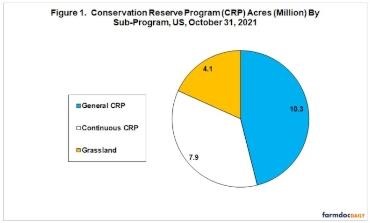
Net Year-over-Year Change
In net, total CRP acres increased 1.5 million during the 2020-2021 program year (see Figure 2). Acres also shifted among the sub-programs. Grassland CRP acres more than doubled, General CRP acres declined 10%, and Continuous CRP acres increased 5%. Continuous CRP is always open for new enrollment.
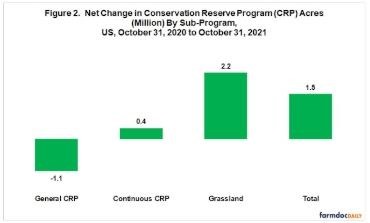
Net Change in Total CRP Acres by State
In net, total CRP acres increased in 17 states and declined in 28 states. Net acres increased by at least 100,000 in 6 states, led by 546,665 acres in Colorado (see Figure 3). Largest net decline was -42,376 acres in Idaho.
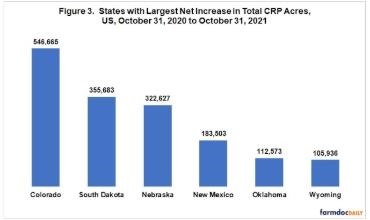
Net Change in General CRP Acres by State
In net, General CRP acres declined for 40 states, with net decline largest in Texas and Kansas (see Figure 4). The 8 states listed in Figure 4 accounted for 70% of the net decline in US General CRP acres. Only 3 states had a net increase in General CRP acres: Utah (+6,763), Wyoming (+4,791), and Alaska (+2,462) .
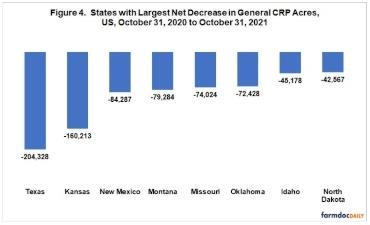
Net Change in Grassland CRP by State
In net, Grassland CRP acres increased in 33 states and declined in 5 states. The 9 states in Figure 5 accounted for 95% of the US net increase. Net increase was largest in Colorado. Net decline was largest in North Carolina, but it was only a -185 acres.
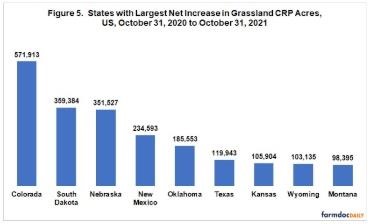
Summary Observations
Even with enhanced program incentives, the 10% net decline in General CRP acres underscores the important role crop prices play in determining General CRP acres.
In contrast, despite high crop prices, acres in Continuous CRP increased a net 5%.
The net decline in General CRP acres reduces CRP’s land retirement role, likely expanding agricultural output. Negative environmental impacts can be minimized if the most environmentally sensitive part of these fields are shifted to Continuous CRP. It would thus be useful to know what share of acres removed from General CRP were shifted to Continuous CRP.
Given the attention to carbon sequestration, both in general and in the 2021 sign ups, it would be useful if USDA explicitly identified what practices sequester carbon and provided quantitative estimates of carbon sequestered by CRP in total and by each of the sub-programs at the end of each CRP reporting year. This information would be particularly useful for the general public audience.
The policy value of an annual carbon sequestration report for CRP would be bolstered by a well-funded and appropriately designed research program to monitor carbon changes in CRP land, thus helping to improve our understanding of the interface between carbon sequestration and farming and environmental practices.
Source : illinois.edu